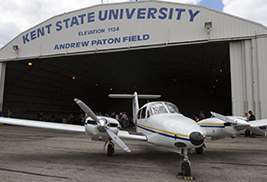Featured Article
Flash-A-Thon Video Raises Awareness for Fundraiser to Benefit Kids With Cancer
Kent State University senior Andy Lovrak was told that making a video to benefit children battling cancer might be too difficult.
read moreKent State University Airport Receives Sustainability Plan Grant
Posted Feb. 23, 2015 | Ashlyne Wilson
The Kent State University Airport has received a Federal
Aviation Administration grant for a master plan to make the
airport a more environmentally and financially efficient
organization.
The Kent State University Airport received a $102,600 grant from the Federal Aviation Administration (FAA) to create and execute a master plan to make the airport a more environmentally and financially efficient organization.
This grant is a part of the $6.4 million FAA Airport Improvement Program to make airports in America the safest and most sustainable in the world.
According to an FAA press release, the airports can use the grants to reduce their noise and water usage, improve air quality and minimize impacts to surrounding communities. Airport management can study, plan and develop sustainability initiatives to be incorporated into existing and future airport projects.
“The FAA just recently launched a program for sustainable master planning,” says David Poluga, the operations coordinator for the airport. “A master plan for an airport is a 20-year plan for how the facilities will be developed, in terms of how it will grow, in terms of operations and in how we’re going to plan to minimize environmental impact. This is why we got the grant.”
Poluga says there are three components to every airport master plan: social, financial and environmental.
“There is a social impact in the sense that we have to be compatible with our neighbors, as well as the financial component, which means we can’t compromise with the other aspects of our organization,” he says. “We have to be self-sufficient and profitable as an organization. Then there is also an environmental component, including the carbon footprint and pollutions that we’re generating as an industrial operation.”
One of the building blocks of the sustainability plan in the Airport Master Plan is the Airport Waste Audit.
The Kent State University Office of Sustainability partnered with the airport to conduct a waste stream assessment to find out what materials were being thrown away or recycled by tenants of the airport.
“We wanted to do a waste audit, and it was done with a consulting firm, C&S Engineers Inc.,” says Leah Graham, Kent State’s outreach recycling coordinator. “The audit was an assessment that we can use to find out what’s in our trash that’s recyclable.”
During the waste audit, all of the trash and recycling at the airport was saved for a week. As the team went through the trash with protective equipment, they sorted the contents into 15 categories.
“We sorted the trash into categories such as metal, office paper, newspaper/magazines and wet waste,” Graham says. “Then, we weighed each category and assessed how full the bins were.”
By weight, the top three recyclable items that the airport generates in its recycling stream are paper, recyclable plastics #1-#7 and newspapers/magazines.
Occasionally, trash accidently gets into the recycling bin. Recyclers can handle a maximum of 10 percent trash contamination in the recyclables. More than that will cause the process of sorting recyclables to become less efficient.
“The tenants are doing a good job at placing only recyclables in the recycle bin, so we’re still below a 10 percent contamination rate,” says Melanie Knowles, Kent State’s sustainability manager.
Knowles says that 55 percent of the trash stream at the airport can be recycled instead of thrown away.
“We want to take that 55 percent out the trash stream into the recyclable stream,” she says. “So we need to know the barrier preventing people from getting those recyclables into the recycling bin. That’s the next part of the process, to create an effective program to increase recycling.”
For more information about the master plan, visit www.faa.gov/news/press_releases/news_story.cfm?newsId=15134.
For more information about the Kent State University Airport, visit http://www2.kent.edu/airport/index.cfm.
